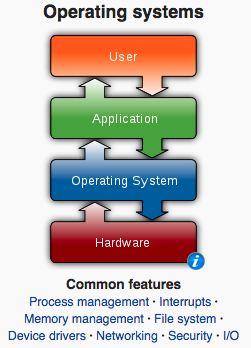Computer resources

Resource Management[1]
A system resource is any usable part of a computer that can be controlled and assigned by the operating system so all of the hardware and software on the computer can work together as designed. System resources can be used by users, like you, when you open programs and apps, as well as by services which are usually started automatically your operating system. Note: A system resource is sometimes called hardware resource, computer resource, or just resource.[2]
Resources which needs to be managed[edit]
| Resource | Description |
|---|---|
| primary memory | Please read this article about Primary memory. |
| persistent storage | Please read this article about Persistent storage |
| CPU | When the OS runs a piece of software it has to find the program files on the storage drive, load them into main memory, and instruct the CPU to start executing the program from the beginning.
In each case, the OS performs the same sequence of steps:
|
| bandwidth | Bandwidth, which is the amount of data that can be transmitted in a fixed amount of time, is expressed in multiples of bits per second in digital devices. In analog devices, it is expressed in hertz. A "bus" with low bandwidth can hamper a fast hard drive. The operating system allocates bandwidth to each program, input or output method. |
| screen resolution | Number of distinct pixels in each dimension that can be displayed. It is usually quoted as width × height for example, "1024 × 768." The Screen resolution depends on the operating system (OS), as such one can change the screen resolution through the OS. |
| disk storage | Disk storage is a storage mechanism where data is recorded using various methods : Electronic, magnetic, optic or mechanical. Disk storage is stored by a computer processor and communicates within a computer with the use of input and output operations (I/O). Disk storage is managed by the operating system by determining when to read and write from a storage point. |
| sound processor | Sound card - provides input and output of audio signals to and from a computer. Most sound cards use a digital-to-analog converter (DAC), which converts recorded or generated digital data into an analog format. The output signal is connected to an amplifier, headphones, or external device |
| graphics processor | A graphics processing unit (GPU) is a specialized electronic circuit designed to rapidly manipulate and alter memory to accelerate the creation of images in a frame buffer intended for output to a display device. [3] |
| cache | Cache memory is a small-sized type of volatile computer memory that provides high-speed data access to a processor and stores frequently used computer programs, applications and data. It is the fastest memory in a computer, and is typically integrated onto the motherboard and directly embedded in the processor or main random access memory (RAM). |
| network connectivity | Network connectivity relates to management of the hardware (network interface card) and the proper realization of the OSI model. Please see OSI model for a deeper understanding. |
Tools you can use to understand what your operating system is doing[edit]
| The OS manages | Linux tools you can use | OS X tools you can use |
|---|---|---|
| Memory | top, htop, free, vmstat | top, vm_stat, (gui) Activity monitor |
| Processes | top | top, (gui) activity monitor |
| Files | File system, df, du, mount, lsof | lsof, (gui) activity monitor |
| Security | fstab, last, who, /var/log/auth.log | last, who, (gui) console |
| CPU Scheduling | perf | (gui) Activity monitor |
| Devices, Device I/O | iotop, iostat | (gui) activity monitor |
| Interrupts | perf | ?? |
| Networks | netstat, top, tcpdump, iptraf, iftop, nmon | netstat, |
an excellent video to get you started[edit]
Visual to help you see this in context[edit]
This image is used with gratitude from wikipedia [4]
Standards[edit]
- Identify the resources that need to be managed within a computer system.
- Evaluate the resources available in a variety of computer systems.
